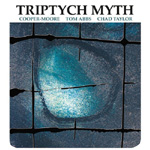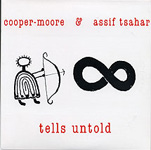Cooper-Moore : Deep Communicative Roots
by Marc Medwin
February 2006
“…And I got back from the tour, pushed my piano out in the backyard and burned it up,” multi-instrumentalist, instrument builder, teacher, and philosopher Cooper-Moore states matter-of-factly, almost gently. “No,” I gasp, visualizing the upright in my living room, imagining trying to get it outside, much less the daunting task of setting fire to it. “No,” he relents, “I had a friend help me with it. I invited this guy from Cameroon over, a guitar player, and we pushed the piano through the living room, through the kitchen, out into the backyard, took a sledgehammer to it, burned up the wood, and…” Salman Rushdie, Günter Grass, and James Joyce all present the microcosmic event as the predecessor and catalyst for all of life’s succeeding events. For Rushdie and Grass, the mere act of envelopment by articles of clothing or bed linen did the trick. For Joyce, it was the striking of a match that determined life’s aftercourse. Much the same can be said of what followed Cooper-Moore’s cataclysmic act of semi-public culmination, destruction or rebirth; it went some way toward precipitating his immensely successful fauret into the world of children’s education, which in turn aided in the continued fostering of a style of music making with deep roots in communication, buried in home soil but always with eyes and ears facing “out” and abroad. The more I listened to Cooper-Moore speak, the more I came to view his creative development as a series of multilayered confluences, of opportunities grasped, often out of necessity, whose fruits were never wasted. To hear him describe his experiences helping the disabled, and I use that term in the broadest possible sense, is to understand the importance of constant and vigilant human-to-human communication pervading all aspects of his life. “So how do you reach people that can only hear low sounds, or only hear high sounds, who have really serious birth defects, who’ve just been cut off from the world, placed in these environments we never see? Well, you put your head to theirs, you hum to them so they can feel it, and it brings on a smile…” He taught children the same way, reducing and explaining incomprehensibilities with a simple song, direct and fun, or by grouping ideas into graspable levels or compartments, a method for which he has received public recognition.  Hearing him speak has proven to be invaluable in my appreciation of his music. Tells Untold and The Beautiful, both collaborative efforts, represent a gentler side of this multifaceted artist. Anybody who knows his work with William Parker’s quartet, In Order to Survive, or his stunning solo piano disc has experienced the deep frustration of one who would destroy the instrument to which he’d dedicated much of his life’s work, but there is an equal measure of playful exuberance in the message. The two discs under discussion here are merely sublimations—anger transmuted into deep sorrow, exuberance becoming serenity in light of gained wisdom, and any degree of separation between these emotive states is increasingly difficult to gauge. Hearing him speak has proven to be invaluable in my appreciation of his music. Tells Untold and The Beautiful, both collaborative efforts, represent a gentler side of this multifaceted artist. Anybody who knows his work with William Parker’s quartet, In Order to Survive, or his stunning solo piano disc has experienced the deep frustration of one who would destroy the instrument to which he’d dedicated much of his life’s work, but there is an equal measure of playful exuberance in the message. The two discs under discussion here are merely sublimations—anger transmuted into deep sorrow, exuberance becoming serenity in light of gained wisdom, and any degree of separation between these emotive states is increasingly difficult to gauge.
The concluding track of The Beautiful (AUM Fidelity)—“Robina Pseudoaccacia”—is starkly illustrative. Basically a monody for solo piano, it contrasts and conjoins chromaticism and its tonal opposite; like the single-note hum of a human voice, presenting myriads of overtones, the result is eerily simple, mysterious in its simultaneous directness and elusiveness. “Pooch (For Wilbur Morris)” is its polar opposite. A simple but obviously heartfelt melody grows out of quiet reflection, through a moment of soul-tinged sanctification and back again, but it is as much a forum for percussionist Chad Taylor to present some beautiful brush work and for Tom Abbs to fill out the lower register by mirroring and augmenting C-M’s left hand. “Papa’s Gin in the Chicken Feed” is irrepressibly funky, but like all the tracks on this piano trio’s sophomore effort, it’s shot through with space, with plenty of room for detail. “When I recorded The Beautiful, I was thinking of the way some players play behind a singer, not just chords, but chords and melody. So I was on the same thing, behind the bass, around the drums.” Essentially, Triptych Myth is accompanying a metasinger, fostering a kind of communication through absence so that a unique trio interplay and aesthetic emerges; or, is Cooper-Moore the singer? “This year, I really felt it—I really began to sing, you know, feeling the voice in my chest, coming up and out my arms through my hands…”  Superficially, Tells Untold could not be more different. A joint project with longtime collaborator and Hopscotch label owner Assif Tsahar, a like-mindedly exploratory multi-instrumentalist, there’s not a note of piano to be heard. Cooper-Moore stretches out on flute, but it is also another chance to hear some of his invented instruments—hoe-handled harp, mouth-bow, ashimba, and diddley-bow. The mouth-bow in particular, spellbinding on “Tribes Gathering”, carries with it the numerous shapes and inflections of the human mouth and of the oral histories inherent in related symbologies. The string, flute, and saxophone accompaniment is modal, beautifully but simply contrapuntal, while the mouth-bow floats effortlessly above, like a voice. Superficially, Tells Untold could not be more different. A joint project with longtime collaborator and Hopscotch label owner Assif Tsahar, a like-mindedly exploratory multi-instrumentalist, there’s not a note of piano to be heard. Cooper-Moore stretches out on flute, but it is also another chance to hear some of his invented instruments—hoe-handled harp, mouth-bow, ashimba, and diddley-bow. The mouth-bow in particular, spellbinding on “Tribes Gathering”, carries with it the numerous shapes and inflections of the human mouth and of the oral histories inherent in related symbologies. The string, flute, and saxophone accompaniment is modal, beautifully but simply contrapuntal, while the mouth-bow floats effortlessly above, like a voice.
I tell Cooper-Moore this, and yes, he says, it is representative of a tribal elder’s voice. “I wanted to get away from just improvising, to focus what Assif and I were doing around a theme or story. We would get together every day and discuss what we wanted to portray.” What emerged, very basically, was an archetypal narrative concerned with power, mutiny, a tribe’s lack of understanding regarding the inner workings of those in power—in short, a myth whose substance is revealed only by musical suggestion. Again, direct communication conceptualized, shaped, and fostered by absence. “The Hunt” simmers, suffused with energy, as various percussion, shofar, and Tsahar’s bass clarinet anticipate the gradual arrival of some nameless squealing thing, and all retreat to the rhetorically evocative sound of a bell. Much of the disc works in similarly cinematic fashion, the title track moving gradually from a reflective flute and harp duet to more raucously “primitive” terrain; the disc is a perfect symbiosis of “roots” music and abstraction… “What do you mean?” Cooper-Moore interjects, his voice rising. “There’s nothing abstract here! That just means you don’t understand something. Every sound has some association, whether people are aware of it or not. Look at the Jaws music! Now everybody knows what that is, but at one point you could have called that abstract. My job as a musician is to present these new sounds in a way that’s associated and accessible. If you hear something enough, you may not understand it, but you get used to it. You know,” he continues, “People like to be shook up. They forget that, see, they forget what it’s like to be tickled until you cry, right? They like to go on those roller coasters, get all mixed up and sick, but you gotta bring em back!” Maybe Blake is the writer closest in spirit to Cooper-Moore. Certainly, “abstractions” and arcane allusions abound in his longer works, but one need go no further than Songs of Innocence and Experience to perceive, in literature, the infinitely simple communicative language Cooper-Moore has forged. It exists, as his album title suggests, Deep in the Neighborhood of History and Influence, and I can only follow, smiling, wherever such a restless mind leads.
|

